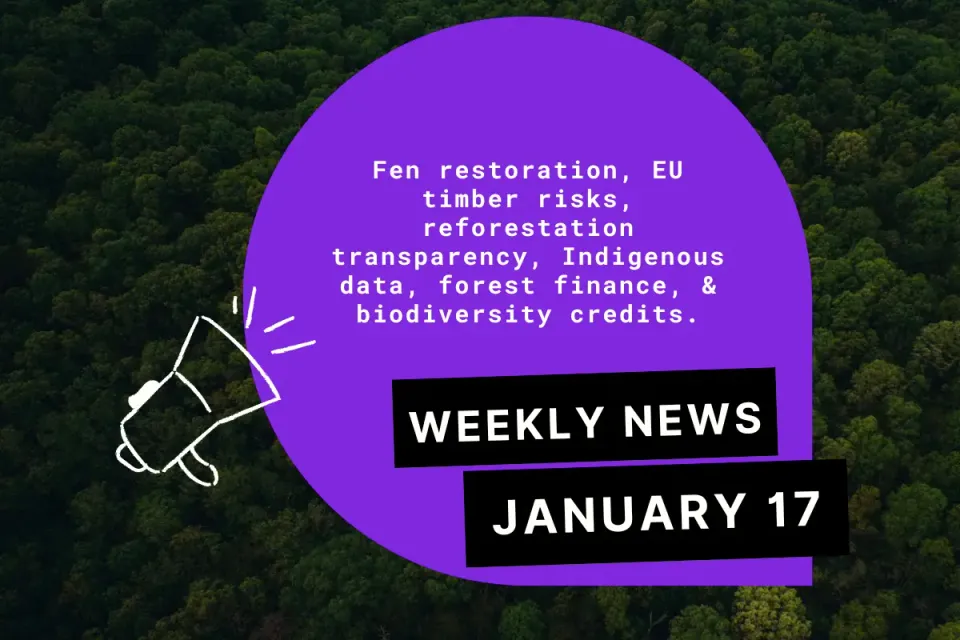Planting Forests to Fight Droughts & Floods in Brazil 🇧🇷
Borges and Curcio say Brazil lacks the federal political will to take the country’s numerous restoration projects from a fragmented, small-scale approach to broad public policy that could be applied and enforced countrywide.

This article by Ellen Metiz originally appeared in Mongabay.
- Many areas of Brazil have been hit with severe droughts and floods in recent years; scientists say climate change is increasing the incidence of extreme weather events.
- Forests protect against erosion and pollution and help store water in soil and aquifers, buoying water security.
- Organizations across the country are leading efforts to reforest cleared areas — particularly along rivers and other water sources —to mitigate the damaging effects of droughts, floods and other effects of climate change, as well as safeguard and improve habitat for wildlife.
- Experts and stakeholders say broader support is needed at the federal level, while a representative of Brazil’s Ministry of Environment and Climate Change says the government is rolling out conservation plans of its own.
ANTONINA, Brazil — In the southern Brazilian state of Paraná, the small coastal town of Antonina gets abundant and high-quality water for its nearly 20,000 inhabitants from a nearby water reserve, one of three that the NGO Wildlife Research and Environmental Education Society (SPVS) established to help bring back biodiversity and water security to degraded areas. To anyone visiting the reserves, it’s difficult to imagine that these thriving forests covering some 19,000 hectares (47,000 acres) were vast voids of buffalo pasture just two decades ago.
Today, nearly the entire area has been restored using dozens of native tree species, and SPVS’s work is ongoing in the seedling nursery, providing an example that it’s possible to repair the degraded natural world.

SPVS founder Clóvis Ricardo Schrappe Borges said that while the restoration project is still in progress, it has already resulted in several boons for the region. In addition to increasing water security, the reserves’ vegetation captures carbon from the atmosphere and provides surrounding towns with revenue from a tax policy called Ecological ICMS, which financially compensates municipalities for establishing reserves, sustainable use areas and Indigenous territories.
The three water reserves are part of an overarching protected area called the Atlantic Forest Great Reserve, an area encompassing 2.7 million hectares (6.7 million acres) of land and another 2.2 million hectares (5.4 million acres) of marine habitat in the states of Paraná, Santa Catarina and São Paulo.
“It’s the largest continuous remaining [area] of this biome, home to Indigenous and traditional communities, historical heritage and, of course, valuable fauna and flora,” Borges told Mongabay in an interview.
A drying country
Paraná isn’t the only state experiencing water concerns; droughts are on the rise in most of Brazil. According to Brazilian research collective MapBiomas, 18.3 million hectares (45.2 million acres) — 2% of the country — was covered in freshwater in 2023, a decline from the historical average. Proportionally, western Brazil’s boggy Pantanal region has lost the most water.
Faced with increasing droughts, conservation groups and government agencies have been looking at a natural solution: planting trees. Preserving and restoring forests, scientists say, is essential for drought protection, as tree roots help channel and store precipitation in the ground and canopies shield the soil from evaporative sunlight.
SPVS isn’t alone in its mission. Many projects, from small, local initiatives to larger and more ambitious ventures, have endeavored to preserve Brazil’s remaining forests and restore sites in which native vegetation has been wiped out. The Biochronos project, for instance, led by the Laboratory of Evolutionary Ecology and Biodiversity at Federal University of Minas Gerais (UFMG), aims to increase the biodiversity and ecological functioning of areas of the Doce River Basin affected by the collapse of a mining tailings dam in 2015.

But participants say that before these projects begin, it’s important to gain a clear understanding of what the restoration target should look like. UFMG analyzed the characteristics of soil collected before the dam disaster — which deposited an estimated 62 million cubic meters (2.2 billion cubic feet) of sediment along the Doce River and is considered the world’s worst tailings dam accident — in order to create a reference that local restoration efforts can use as a baseline.
“Understanding how ecological and life-history traits of plant species relate with [soil] factors is an important step to provide scientific-based knowledge to support policies for ecosystem recovery and restoration in the stretches of the Rio Doce watershed,” UFMG researchers wrote in their study, which was published earlier this year.
Beyond drought protection
Riverbank, or “riparian,” vegetation doesn’t just protect against droughts. During periods of heavy rain, forest cover reduces the flow of water from land into rivers, lowering the risk of floods; vegetation also prevents erosion, as roots help hold soil in place.
Severe floods have hit the southern state of Rio Grande do Sul at least four times since late 2023; the severest instance was in May 2024, which resulted in the displacement of more than 581,000 people and the deaths of 169. Scientists say climate change is increasing the incidence of extreme precipitation events.

The Taquari Valley region of southwestern Brazil has been particularly affected by such events. Only 10% of its native riparian vegetation remains, according to unpublished research conducted by the Taquari Valley Riparian Forest Movement, an independent civil society association that recently began working to restore the valley’s vegetation using native species. More than 4 million seeds from 20 species have been collected by an association task-force of volunteers and a handful of researchers and technicians, as well as private and public institutions. The association also aims to restore the region’s soil, which has been degraded by recent flooding, as well as monitor and combat invasive species.
“What we’re proposing, which is to rebuild the riparian forests, is essential so that we don’t end up being destroyed with every flood,” said Karina Barth Ludvig, a biologist affiliated with the Taquari Valley Riparian Forest Movement. “But it’s not a quick measure. Our idea is to raise awareness, hold environmental education events, support technical studies, and carry out technical studies and assessments.”
Riparian forests provide many other ecosystem services in addition to protection against floods, including shielding water sources from pollution.
“River forests have many functionalities,” said Gustavo Ribas Curcio, an agronomic engineer and researcher at state-owned Brazilian Agricultural Research Corporation (Embrapa). “A robust and sufficiently wide forest prevents or minimizes the entry of sediments, pesticides, fertilizers, etc. that come from erosion of the slopes.”
Curcio added that preserving and restoring forests along rivers and other bodies of water also helps safeguard wildlife.
“The greater the diversity of the forest, the greater the niches for sheltering fauna [and protecting] ecological corridors,” he said. “This is an even more important factor than the extent of the forest itself. These forests are also capable of becoming a stronghold for tree species that are no longer found in areas dominated by agribusiness.”
To reap the most benefits, Curcio said, care must be taken to restore an area in the right way. This includes restoring upstream to downstream to mitigate re-degradation of an area due to issues further up the river that could flow downstream. Other factors to consider, according to Curcio, include non-tree vegetation diversity, soil characteristics, local climate, topography, and other landscape characteristics.

A drop in the ocean
While these initiatives are yielding benefits locally and regionally, conservationists say efforts need to be made on a larger scale to guarantee the needs of both nature and people across the country. However, Borges and Curcio say Brazil lacks the federal political will to take the country’s numerous restoration projects from a fragmented, small-scale approach to broad public policy that could be applied and enforced countrywide.
“The projects are very limited [to specific regions],” Curcio said. “What we lack is civil awareness. We haven’t built public policies that give us a stronger position on this issue.”
According to Brazilian legislation known as the Forest Code, vegetation “with the environmental function of preserving water resources, the landscape, geological stability and biodiversity, facilitating the gene flow of fauna and flora, protecting the soil and ensuring the well-being of human populations” are considered permanent preservation areas.
The law also states that the size of the area of vegetation to be preserved is dependent on the length and type of the water body. But, according to Curcio, this strategy is wrong because it doesn’t consider other important factors such as the terrain’s slope and soil characteristics.
“What causes ecological tension is not the width of the river, but the banks and sides of the slopes,” he said. “A sandy soil, for example, suffers more from erosion than a clay soil.”
In 2012, the government changed the Forest Code to loosen requirements on the size of water body vegetation buffers. Borges expressed concern over this, saying the change allowed landowners to preserve less forest, adding that enforcement is also an issue.
“The far-reaching changes to the Brazilian Forest Code in 2012 led to a significant weakening of safeguards for biodiversity conservation on private properties,” Borges said.
When reached for comment, a representative of Brazil’s Ministry of Environment and Climate Change refuted that the 2012 policy changes were significant.
“Law No. 12.651/2012 requires the conservation of at least 30 meters [about 100 feet] around water courses, with exceptions provided for in the legislation, such as in rural areas consolidated until 2008,” the representative told Mongabay in an email. “The limits imposed by the Forest Code are minimum, however, meaning that states and municipalities can make them stricter in their regulations.”
They added that the federal government offers financial and other kinds of incentives for the protection of riparian forests, and recently approved a new forest protection plan.
“Within the scope of the Safra Plan, for example, rural properties that have completed the analysis in the Rural Environmental Registry have a 0.5% discount on the interest rate,” the representative said.

The Ministry of Environment and Climate Change and the Ministry of Agriculture and Livestock are also working to develop low-rate credit lines to stimulate the conservation of native vegetation, which will contribute to maintaining water resources.
“Another measure is the approval on October 11 of the National Plan for the Recovery of Native Vegetation,” the representative wrote. “Expected results include the drafting and approval by the National Water Resources Council of a guideline for River Basin Committees and their Water Agencies to prioritize the allocation of funds collected from water use to support the recovery of Permanent Preservation Areas and Legal Reserves, in priority areas.”
Borges said that despite all challenges, he’s hopeful for a future in which “the qualified management” of natural reserves could “stimulate the protection of other areas, both public and private, by incorporating the value of nature conservation into business.”
Citations:
Figueiredo, J. C., Negreiros, D., Ramos, L., Paiva, D. C., Oki, Y., Justino, W. S., … Fernandes, G. W. (2024). Reference sites of threatened riverine Atlantic Forest in upper Rio Doce watershed. Nature Conservation Research, 9(1), 58-71. doi:10.24189/ncr.2024.006
Feedback:Use this form to send a message to the editor of this post. If you want to post a public comment, you can do that at the bottom of the page
License
Nemitz, E. (2024, November 18). Organizations tackle droughts, floods in Brazil by planting forests. Mongabay. Republished under a Creative Commons Attribution-NoDerivatives 4.0 International License.




